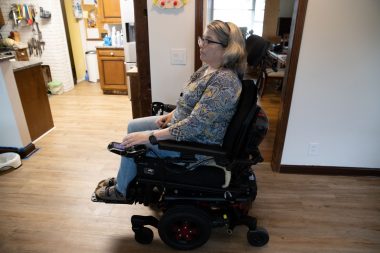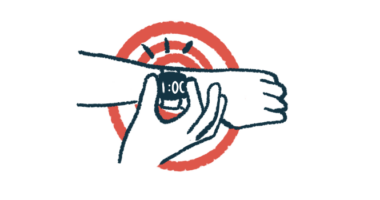Technology Helping to Make Registries, Databases More Efficient
Advances in AI, computing, and smartphones aid efforts to collect data

In amyotrophic lateral sclerosis (ALS), as in many diseases, patient registries, biorepositories, and natural history studies are helpful both in planning clinical trials and as tools for scientists to learn more about how a person’s lifestyle, genetics, and environment can potentially lead to ALS. These databases also might help in finding new ways to treat the disease.
ALS is a rare condition for which not much data are available. But ALS-related institutions are making it easier and more efficient to collect data housed on platforms such as registries, thanks to technological advances in artificial intelligence (AI), computing, and smartphones.

Erin Dittoe uses her power chair when she becomes tired. (Photo by David Petkiewicz)
Erin Dittoe, 55, was diagnosed with ALS two years ago and is sharing her health data in a number of different ways.
She has registered with the National ALS Registry from the Centers for Disease Control and Prevention (CDC), taken part in genetic testing, and wears a watch that tracks her movements for an observational clinical trial (NCT05276349). That trial is seeking to determine if at-home measurements might replace repeated in-person clinic visits.
Diagnosed with sporadic ALS — the most common type, where there is no family history — in November 2020, Dittoe’s disease progression has been slow. She can walk with assistance, speak (albeit slowly), and work from home.
The Ohioan hopes the information she contributes will help scientists better understand what causes ALS and how to treat it.
“I kind of feel as though [it’s] for the people that can’t answer questions for one reason or another, it’s for them,” Dittoe said. “It’s doing my part.”

Fernando Vieira is the CEO and chief science officer of the ALS TDI. He has been with the nonprofit for 20 years. (Courtesy of ALS TDI).
The ALS Therapy Development Institute (ALS TDI), a nonprofit focused on disease research, is enlisting Google’s help to streamline its data analysis and use of patient data. Google’s application programming interface forms the analytical backbone of its Precision Medicine Program (PMP), which currently has data covering 813 fully enrolled patients — those who contributed three or more months worth of information. The PMP project, initiated in 2014, stores information about a patient’s movement abilities, medical history, genetics, biomarkers, and clinical measurement scores, as well as voice recordings.
According to Fernando Vieira, MD, CEO and chief scientific officer of the ALS TDI, Google’s Looker platform, as the interface is called, is a big data analytics platform used primarily for business intelligence. The powerful tool allows researchers to look up people’s information — as detailed as their genome, for some — and compare it to their disability progression, as measured by the ALS Functional Rating Score-Revised (ALSFRS-R).
Identifiable information — including participants’ names, Social Security numbers, or email addresses — is not available to researchers. Data that could identify any individuals are protected under the Health Insurance Portability and Accountability Act (HIPAA) of 1996 in the U.S. Each participant is only referenced as a number.
To date, ALS TDI has captured 9,873 voice recordings, 19,404 ALSFRS-R scores, and 7,422 weeks of data from patients wearing accelerometers, which calculate how much each wearer is moving.
ALS TDI considers it important to share the collected data with patients, Vieira said, so they can track their own health.
“A key tenet of our program from the beginning has been to treat our participants as partners,” Vieira said. “That, I think, has been key to maintaining compliance and commitment to the efforts, and I would encourage that.”
Recognizing patient ‘voices’
In 2018, ALS TDI also partnered with Google on Project Euphonia, which aims to use artificial intelligence to help people with impaired speech (dysarthria) — a common ALS symptom — interface with voice recognition on its platforms, such as the Google Pixel smartphone.
Google is using available PMP voice recording data to train its AI in interpreting speech with dysarthria. The first publicly available tool to come from Project Euphonia, Project Relate, is an app that’s now in beta testing.
Speech recognition software, such as that used with Siri or Google Home, recognizes wavelengths that correspond to spoken words. It pieces those words together and, through a series of steps, arrives at an understanding of someone’s speech and commands — for example, “Turn off the lights.” But it can only interpret phrases based on the quality of the voices used to train it. People with speaking impairments, whose voices typically are not part of a software’s training parameters, often struggle to use this technology.
Loss of vocal clarity and strength are common with ALS. In a YouTube Original documentary about AI, the father of former NFL linebacker Tim Shaw recounts his son’s frustrations with his increasing lack of clarity in speaking. As his ALS progressed, the former football player had to change his phone’s contact information from “Dad” to “Yo-yo” because it couldn’t understand Shaw’s command to “call Dad.”
ALS TDI’s work with Google also created an algorithm, derived from machine learning, that might better track changes in disease severity based on a patient’s speech and movement data than do ALSFRS-R tests taken at a given time. The code behind the tool has been made available for scientists to use and continue to improve.
While such technology still is being refined, its use continues to grow. As part of her trial, Dittoe is recording her voice into an application that aims to track disease progression through changes in speech.
What blood samples and earlier HIV work might teach
With its PMP project, ALS TDI also is collecting data from patients’ blood samples, looking for biological measures of disease progression. This work is supported by a $281,000 grant awarded the institute in March by the Congressional Directed Medical Research Programs, part of the U.S. Department of Defense.
ALS TDI plans to send blood samples, collected quarterly over one year, to SomaLogic, a Colorado company, “to observe the concentrations of thousands of cytokines, growth factors, … kinases, structural proteins, hormones, and other proteins in each sample” that might serve as biomarkers.
Vieira compares the race to cure ALS to the charge to find treatments for HIV.
In the mid-1990s, scientists conducting a natural history study of HIV found a certain genetic variation conferred resistance to the virus. Specifically, they discovered that people with genetic mutations leading to a “nonfunctional,” or inactive, CCR5 receptor protein were “highly resistant” to the infectious disease. This pointed to CCR5 as a promising target for preventing HIV infection.
Through a study “designed to teach you,” Vieira said, scientists were able to more quickly develop “drugs targeting that receptor” and better treat HIV.
“They were able to reveal that you can go into a natural history study knowing nothing and allowing it to show you something,“ he said, adding, “And that’s how, I think, we’ve gone into this [ALS data] … assuming we know very little, collecting as much data as we can, and then allowing it to show us what is important over time.”
Like that HIV natural history study, whose scientists “didn’t know how many people they needed, or how long they’d have to look … we don’t know how many people we need or how long we’re going to have to look,” Vieira said. “But it will be the source of a lot of our answers.”
This article is the second of a three-part series published as part of the Rare Disease Fellowship through the National Press Foundation. To read Part 3, go here. To read Part 1, go here.








